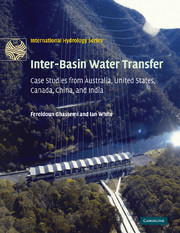Book contents
- Frontmatter
- Contents
- Foreword
- Overview and Scope
- Acknowledgements
- List of Abbreviations
- Part I The Challenges
- Part II Inter-basin Water Transfer in Australia
- Part III Inter-basin Water Transfer in Other Selected Countries
- 11 Inter-basin water transfer in the United States of America
- 12 Inter-basin water transfer in Canada
- 13 Inter-basin water transfer in China
- 14 India: The National River-Linking Project
- 15 Inter-basin water transfer, successes, failures and the future
- Part IV Appendices
- Glossary
- Index
15 - Inter-basin water transfer, successes, failures and the future
Published online by Cambridge University Press: 05 November 2009
- Frontmatter
- Contents
- Foreword
- Overview and Scope
- Acknowledgements
- List of Abbreviations
- Part I The Challenges
- Part II Inter-basin Water Transfer in Australia
- Part III Inter-basin Water Transfer in Other Selected Countries
- 11 Inter-basin water transfer in the United States of America
- 12 Inter-basin water transfer in Canada
- 13 Inter-basin water transfer in China
- 14 India: The National River-Linking Project
- 15 Inter-basin water transfer, successes, failures and the future
- Part IV Appendices
- Glossary
- Index
Summary
INTRODUCTION
World population is projected to reach 9.3 billion by 2050, about 50 percent higher than the 2000 population of 6.1 billion. While global freshwater resources are adequate for that population and its water-dependent support systems, the uneven spatial distribution of freshwater means that by 2050 nearly two thirds of the world's population will live in water-stressed countries. Water shortages and extreme events are expected to be exacerbated by the impacts of global warming and land use changes. The problems that individual governments face in both limiting and supplying demand, in finding adequate sources of freshwater and in protecting communities and ecosystems are complex and difficult. As shown in this book, inevitably, decisions involve a trade-off between competing elements. There are no simple, universal solutions because of context-specific factors and location-dependent political considerations. None the less some lessons do emerge from analysis of the past inter-basin water transfer projects.
World water resources were developed rapidly over the past century to satisfy increasing demands. Large dams and numerous inter-basin water transfer projects have been constructed in all continents. It has been estimated that globally about 47 000 high dams have been built for town water supply, irrigation, flood control and hydro-power generation. The total investment in large dams is estimated at more than US$2000 billion. Global water withdrawal has increased approximately seven-fold from about 579 × 109 m3 in 1900 to 3917 × 109 m3 in 2000 compared with only a four-fold increase in population from 1.5 billion to 6.1 billion in the same period.
- Type
- Chapter
- Information
- Inter-Basin Water TransferCase Studies from Australia, United States, Canada, China and India, pp. 345 - 358Publisher: Cambridge University PressPrint publication year: 2007



